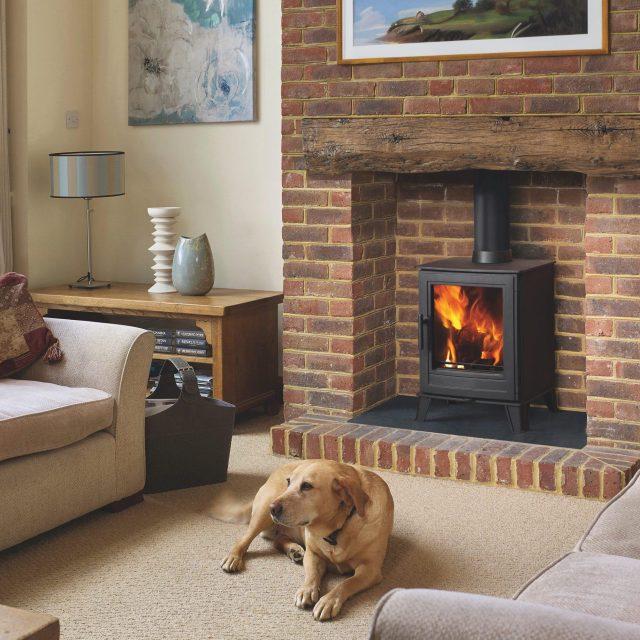




A wood-burning stove requires professional installation to ensure it meets regulations. Failing to meet wood burner regulations could mean a breach of the law, not to mention posing a danger to the safety of your home.
In this article, we’ll guide you through the need-to-know regulations for installing a new wood-burning stove.
Changes to your chimney are categorised as building work. This means you need to adhere to certain Building Regulations during the installation process. The most relevant Building Regulations document for wood burners can be found here and key points will be covered in this article.
By arranging your installation with a HETAS-approved specialist, such as Enviro-Flame, they will ensure the installation adheres to the relevant wood-burning stove regulations without you needing to research it for yourself.
You do not require planning permission to install a wood-burning stove if you are using the services of a HETAS-approved installer. That is because a HETAS-approved professional has a certificate of compliance to ensure they are working within building regulations.
If you are fitting the wood-burning stove yourself or are using an installer without HETAS compliance, you must inform your local Building Control department, which needs to make sure that you are complying with building regulations. The latter approach can cost more and sometimes delay the project.
Failure to use a HETAS-approved installer and not inform the Building Control department may incur a fine.
Log burner installation regulations do not specify that you have to be a HETAS-approved installer to fit a log burner.
However, if the installer is not HETAS-approved, there will be additional steps to comply with, namely informing the Building Control department of your plans so that they can inspect and approve the installation to ensure it complies with regulations.
Legally, you are not required to get a flue liner for a wood-burning stove if the chimney is in good condition. However, it is strongly advised to fit your chimney with a flue liner for the health and safety of everyone in the home.
The benefits of flue liners include:
Chimneys should be inspected before a stove is installed. If your chimney has cracks or other damage, or if it’s especially large in size, then it must be fitted with a flue liner. A professional fireplace fitter or registered chimney sweep can advise further on your specific needs to ensure you are compliant.
As always, please refer to the stove manufacturers instructions for their advice.
Firstly, it is advised to fit a carbon monoxide alarm in your home regardless of whether or not you have a wood-burning stove.
If you do install a wood-burning stove, you legally must have a carbon monoxide alarm in the same room as the stove itself.
Other ways of protecting your home against carbon monoxide include fitting a flue liner and ensuring your chimney is inspected at least once a year.
Please always refer to the CO alarm manufacturers instructions on where to fit the alarm.
Stoves require an adequate air supply to burn effectively. Lack of proper ventilation can result in incomplete burning of fuel or smoke filling your home.
There are different ventilation requirements based on how ‘air-tight’ your property is. It is this air permeability measurement that will determine the ventilation requirements that your stove will need.
Houses built before 2008 and houses built after 2008 or have had significant refurbishment carried out have to meet different air permeability measurements so it’s worth getting this tested by a professional.
All stoves over 5kW nominal heat output will require ventilation and your installer will be able to advise on how much ventilation is required.
A qualified fireplace and stove expert, such as Enviro-Flame, will be able to advise on the ventilation you will need depending on the heat output of your particular stove and the air permeability of your home.
Hearth requirements for wood-burning stoves dictate that the stove must be placed on a non-combustible material, and options include steel and granite, amongst others.
Another requirement is if the heat output raises the hearth’s temperature over 100°C, it must be at least 250 mm thick.
If the heat output does not raise the hearth’s temperature above 100°C, it must be at least 12 mm thick. It must also span a full area of 840 x 840 mm. It must also reach at least 150 mm to the sides and 300 mm from the front.
Please refer to the manufacturers instructions for their minimum dimensions required.
All wood-burning stoves put on the market or purchased after January 2022 must comply with the new Eco Design to reduce harmful air pollution. If your stove was put on the market or purchased prior to January 2022, then it does not need to comply.
Many large urban areas are now smoke control zones which means that you must either burn smokeless fuels or use a DEFRA-exempt stove. This is put in place to support the Clean Air Act in maintaining healthy air for citizens.
Are you looking for a HETAS-accredited installer in London? Here at Enviro-Flame, we’ve become the capital’s leading fireplace and stove supplier and fitter, ensuring you stay in total compliance with national regulations. To find out more, get in touch or arrange a visit to our showroom.